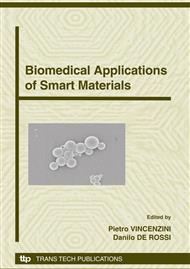p.5
p.15
p.22
p.31
p.37
p.44
p.50
p.55
p.61
Photoluminescence Response and Particle Size Control of CdSe Quantum Dots by Wet Chemical Synthesis for Biomedical Applications
Abstract:
The chalcogenide CdSe quantum dots (QDs) were obtained by wet chemical synthesis route, using cadmium oxide and pure selenium as precursors, hexadecylamine (HDA), tetradecylphosphine oxide (TDPO) and tri-n-octylphosphine oxide (TOPO) as complexing agents in tri-n-butylphosphine (TBP) solvent in the reactor with an argon protection atmosphere. This study aims at manipulating the size of QDs for the potential in vivo medical applications. The CdSe nanoparticles were analyzed by particle size analyzer, photoluminescence (PL) spectroscopy, FE-SEM, TEM, and XPS. The desired particle size and photoluminescence response of CdSe QDs can be achieved by adjusting proper molar ratios of HDA/TOPO and CdO/Se, along with the synthesis temperature and reaction time. Our results show that the obtained CdSe quantum dots have the average particle size of 1~10 nm within a size variation of 1.5 nm. The resultant CdSe QDs provide stable PL responses as excited by light sources of 388~550 nm wavelengths.
Info:
Periodical:
Pages:
37-43
Citation:
Online since:
September 2008
Authors:
Price:
Сopyright:
© 2008 Trans Tech Publications Ltd. All Rights Reserved
Share:
Citation:


